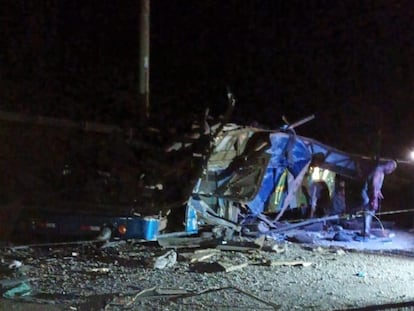Migrants start fire at Mexico detention center, killing 40
President Andrés Manuel López Obrador said the fire was started by migrants inside the facility in Ciudad Juárez, near the U.S. border, after learning they would be deported
Migrants fearing deportation set mattresses ablaze at an immigration detention center in northern Mexico, starting a fire that left 40 dead, the country’s president said Tuesday following one of the the deadliest incidents ever at an immigration lockup in the country.
Hours after the fire broke out late Monday, rows of bodies were laid out under shimmery silver sheets outside the facility in Ciudad Juarez, which is across from El Paso, Texas, and a major crossing point for migrants. Ambulances, firefighters and vans from the morgue swarmed the scene.
Thirty-nine people died and 29 were injured and are in “delicate-serious” condition, according to the National Immigration Institute. There were 68 men from Central and South America held in the facility at the time of the fire, the agency said. A Guatemalan official said many may have been from that Central American country.
President Andrés Manuel López Obrador said the fire was started by migrants inside the facility in protest after learning they would be deported.
“They never imagined that this would cause this terrible misfortune,” López Obrador said, adding that the director of country’s immigration agency was on the scene.
Tensions between authorities and migrants had apparently been running high in recent weeks in Ciudad Juarez, where shelters are full of people waiting for opportunities to cross into the U.S. or who have requested asylum there and are waiting out the process.
More than 30 migrant shelters and other advocacy organizations published an open letter March 9 that complained of a criminalization of migrants and asylum seekers in the city. It accused authorities of abuse and using excessive force in rounding up migrants, complaining that municipal police were questioning people in the street about their immigration status without cause.
The high level of frustration in Ciudad Juarez was evident earlier this month when hundreds of mostly Venezuelan migrants acting on false rumors that the United States would allow them to enter the country tried to force their way across one of the international bridges to El Paso. U.S. authorities blocked their attempts.
The national immigration agency said Tuesday that it “energetically rejects the actions that led to this tragedy” without any further explanation of what those actions might have been.
In recent years, as Mexico has stepped up efforts to stem the flow migration to the U.S. border under pressure from the American government, the agency has struggled with overcrowding in its facilities. And the country’s immigration lockups have seen protests and riots from time to time.
Mostly Venezuelan migrants rioted inside an immigration center in Tijuana in October that had to be controlled by police and National Guard troops. In November, dozens of migrants rioted in Mexico’s largest detention center in the southern city of Tapachula near the border with Guatemala. No one died in either incident.
Mexico has emerged as the world’s third most popular destination for asylum-seekers, after the United States and Germany, but is still largely a transit country for those on the way to the U.S. It holds tens of thousands of migrants in an expansive network of detention centers and attempts to closely monitor movements across the country in cooperation with American authorities.
Karla Samayoa, spokeswoman for Guatemala’s Foreign Ministry, said that Mexican authorities had informed them that more than two dozen of the migrants who died appeared to be from the country.
Asylum-seekers must stay in the state where they apply in Mexico, resulting in large numbers being holed up near the country’s southern border with Guatemala. Tens of thousands are also in border cities with the U.S., including Ciudad Juarez.
The Strauss Center for International Security and Law at the University of Texas at Austin has estimated there are more than 2,200 people in Ciudad Juarez’s shelters and more migrants outside shelters from Venezuela, Nicaragua, Colombia, Guatemala, Ecuador, Peru, and El Salvador.
Sign up for our weekly newsletter to get more English-language news coverage from EL PAÍS USA Edition
Tu suscripción se está usando en otro dispositivo
¿Quieres añadir otro usuario a tu suscripción?
Si continúas leyendo en este dispositivo, no se podrá leer en el otro.
FlechaTu suscripción se está usando en otro dispositivo y solo puedes acceder a EL PAÍS desde un dispositivo a la vez.
Si quieres compartir tu cuenta, cambia tu suscripción a la modalidad Premium, así podrás añadir otro usuario. Cada uno accederá con su propia cuenta de email, lo que os permitirá personalizar vuestra experiencia en EL PAÍS.
¿Tienes una suscripción de empresa? Accede aquí para contratar más cuentas.
En el caso de no saber quién está usando tu cuenta, te recomendamos cambiar tu contraseña aquí.
Si decides continuar compartiendo tu cuenta, este mensaje se mostrará en tu dispositivo y en el de la otra persona que está usando tu cuenta de forma indefinida, afectando a tu experiencia de lectura. Puedes consultar aquí los términos y condiciones de la suscripción digital.
More information
Archived In
Últimas noticias
Most viewed
- Pablo Escobar’s hippos: A serious environmental problem, 40 years on
- Reinhard Genzel, Nobel laureate in physics: ‘One-minute videos will never give you the truth’
- Why we lost the habit of sleeping in two segments and how that changed our sense of time
- Charles Dubouloz, mountaineering star, retires at 36 with a farewell tour inspired by Walter Bonatti
- The Florida Keys tourist paradise is besieged by immigration agents: ‘We’ve never seen anything like this’










































